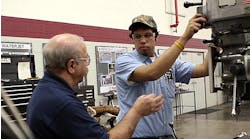The federal government estimates that manufacturing operations use about one third of the total amount of energy consumed in the U.S. annually. So, manufacturing companies can play an important role in building a sustainable future.
The good news is that manufacturing engineers — especially design and manufacturing engineers — are already stepping up to the challenge. Every day, engineers design products that conserve energy, reduce waste, and eliminate pollution, and they manufacture those products in sustainable ways.
But there’s more work to be done. And the present climate of economic and environmental concerns challenges engineers to optimize manufacturing processes and make them more sustainable.
Here are six key steps to be taken to make manufacturing more sustainable. The first two are pretty obvious, and many of us are doing a good job with these. But, the four items that follow are things design engineers need to be thinking about constantly.
1. Optimize your current use of fossil fuels.
This is a given. Cutting energy cost is a win-win situation in today’s environment. There seems to be little argument that we are close to “peak oil,” i.e., availability, when half of the world’s known oil reserves have been consumed. The only argument left is when the supply crunch will start, or if it has already begun. Save now by turning off machinery when it is not being used. Replace a single-speed motor with a variable-speed or servo drive to reduce energy consumption. Use a variable-speed hydraulic pump. Also, take a look at other alternative sustainable sources of energy — whether that’s wind, solar, or hydroelectric power.
2. Eliminate waste.
Another no-brainer. Consume only the supplies and resources that you need to produce the finished product. Sounds very simple to us today, but I think we all know that, in the past, our primary objective was to reduce production costs or time to market. Nobody knew or cared whether we were using more resources than we needed. This applies to every industry … whether it’s the amount of metal, paper, packaging material, etc. used. Re-evaluate whether or not the choice of investing in precision manufacturing equipment can be justified by looking at the ways it may introduce opportunities for waste reduction.
3. Reduce, or eliminate, pollution.
Lately, whenever I meet colleagues at conferences or trade shows, one of the hot topics is how to reduce the use of “environmentally unfriendly” materials in production, as well as by-products of manufacturing processes. I hear renewed interest in dry, or near-dry, machining, using as little coolant as possible while performing metal removal. Or de-burring, taking the burrs off of finished material after it’s been cut, another process that uses quite a few powerful chemicals.
4. Recycle.
Look at the amount of metal chips that are made in machining and finishing processes. People used to just fill up huge hoppers, and haul them to a recycling facility. Now they’re starting to look at the cost of energy involved in all this. One solution is “chip puckers,” devices that compress chips, remove the coolant, and form the metal into “hockey pucks,” which are a lot easier to transport and require a lot less energy. Or, even better, they could invest in equipment for handling the chips in-house, such as processing them into small billets that can be recycled on site.
5. Recover energy, don’t turn it into heat!
Hybrid cars recover energy that otherwise is wasted during braking; did you know machines can do it too? Power sharing has its roots in machine tools, where the servos used in metalcutting machines and seam machines share power through a single power supply. We can actually take power during deceleration and return it to the main lines. In the past, that energy was wasted, turned into heat, like the brakes on a car.
Another great example is the way some operations are able to coordinate the cycles of several metal presses. At first you might think, “Have all the presses go up and down together and then move the material.” But, we’ve found that if you skew the cycles slightly, you can use the decelerated, regenerative power in one press to help accelerate the other one. That has no effect on the process time, no effect on the cycle time, and it doesn’t cost more, but it saves energy. We’ve started to apply our knowledge of shared servo power to other industries like packaging machinery, automation, and printing presses.
6. Save Time
Just saving time is, by itself, an indirect energy savings. If you can run a cycle faster without using more energy to do it, you can shut it down and save power. Or, if it’s a large-scale high-production facility, you can reduce the number of machines you need to produce the same quantity of material.
All of these are challenges engineers are meeting, and they are what will make manufacturing sustainable in the coming years. In our own organization, we have many people who just love a good challenge like “How can I make this product consume less energy?” and “How can I make the product while using the least possible amount of resources?” You can really see it on people’s faces every day.
Unfortunately, when most people hear about sustainability, they think of “big ticket” items — like solar panels or wind farms. But, though they may not have the glamour or get all the attention, it’s the” workhorse” devices like servo drives, hydraulic pumps, bearing assemblies that will create the sustainable manufacturing of the future. I think we prove that to ourselves and to our customers on a daily basis.









